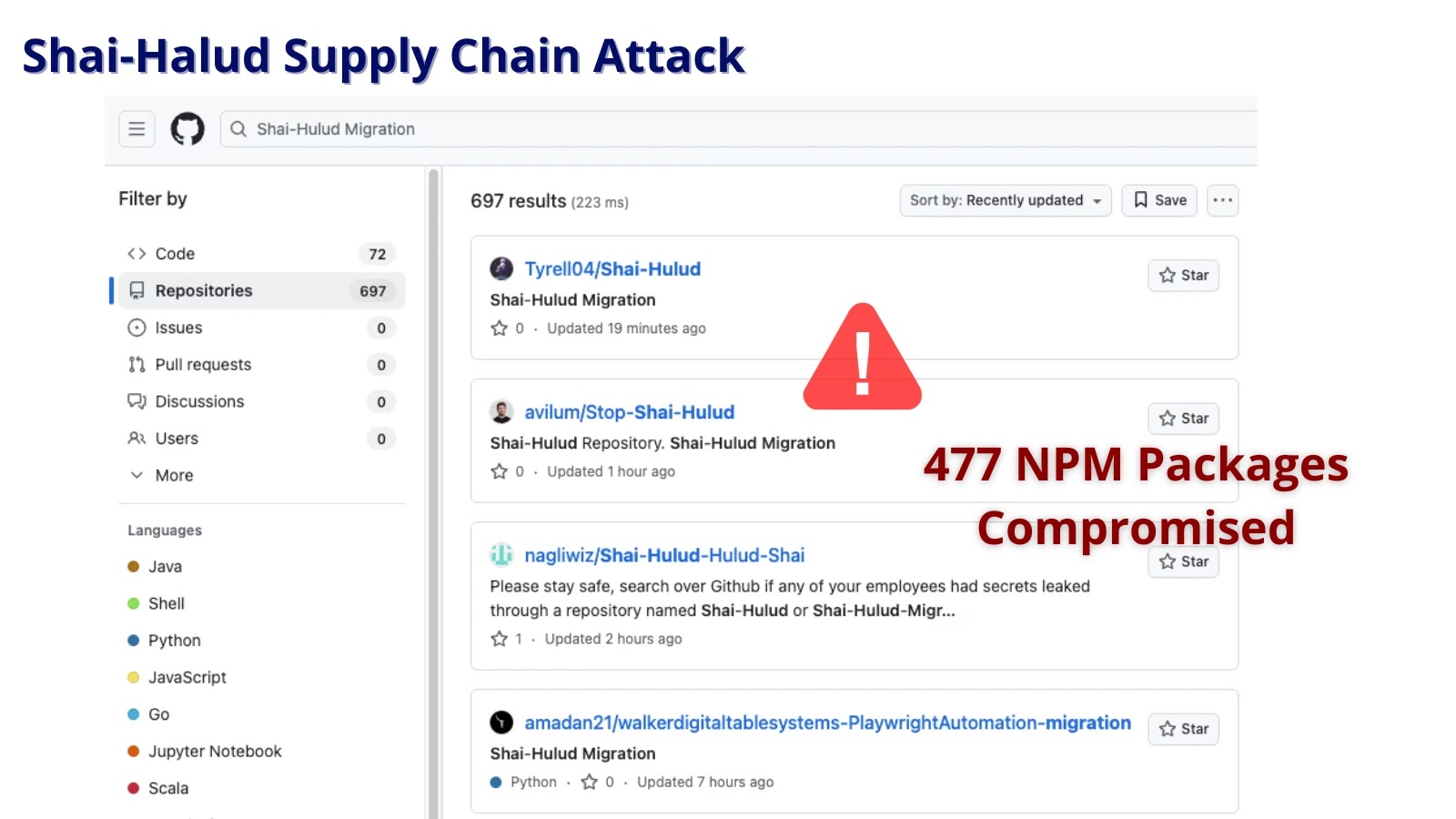
Massive “Shai-Halud” Supply Chain Attack Compromised 477 NPM Packages
The JavaScript ecosystem, a cornerstone of modern web development, has once again been rocked by a sophisticated supply chain attack. Dubbed “Shai-Halud,” this large-scale infiltration of the npm registry underscores the persistent vulnerabilities within open-source package management. Developers, security professionals, and organizations leveraging JavaScript must urgently understand the mechanics and implications of this pervasive threat.
This incident, which stealthily compromised 477 npm packages, highlights a critical, often underestimated, attack vector: the supply chain. From credential harvesting to remote code execution, Shai-Halud demonstrates the severe consequences when malicious actors successfully inject backdoors into widely used software components.
Anatomy of the Shai-Halud Supply Chain Attack
The “Shai-Halud” attack targeted the npm registry, a central repository for JavaScript packages, by injecting malicious code into numerous legitimate projects. This method, typical of supply chain attacks, leverages the trust developers place in open-source dependencies. The compromised packages were weaponized to perform several nefarious activities:
- Credential Siphoning: Malicious modules were designed to steal sensitive information, including developer credentials, API keys, and access tokens, directly from developer machines or build environments.
- Source Code Exfiltration: Attackers sought to exfiltrate proprietary source code, potentially leading to intellectual property theft or further exploitation down the line.
- Remote Code Execution (RCE): The most critical impact was the ability to achieve RCE on developer machines. This level of access grants attackers full control, enabling them to deploy further malware, compromise internal networks, or escalate privileges.
Crucially, the success of Shai-Halud lay in its stealth. The backdoors were likely obfuscated, making detection challenging for standard security tools and human review. The sheer volume of affected packages—477 in total, including some used by security giants like CrowdStrike—underscores the broad reach and potential impact of this campaign.
Understanding the Impact on the JavaScript Ecosystem
The JavaScript ecosystem, with its reliance on thousands of interconnected npm packages, presents an attractive target for attackers. A single compromised package, when incorporated into millions of projects, can propagate malicious code across a vast digital landscape. The Shai-Halud attack exemplifies this domino effect.
Organizations and individual developers who utilized any of the 477 compromised packages are at risk. The implications extend beyond direct compromise, potentially affecting end-users of applications built with these tainted dependencies. Trust in open-source software, while fundamental to innovation, necessitates robust security practices to mitigate such threats.
Remediation Actions and Proactive Defenses
Addressing the aftermath of “Shai-Halud” and preventing future supply chain attacks requires a multi-faceted approach. Immediate response actions and long-term preventative measures are crucial:
- Audit Dependencies: Immediately audit all npm package dependencies for signs of compromise, specifically checking for the 477 affected packages. Tools detailed below can assist in this process.
- Rotate Credentials: If your development environment or CI/CD pipelines used any of the compromised packages, assume credentials have been exposed. Immediately rotate all sensitive credentials, API keys, and SSH keys.
- Isolate and Rebuild: For affected systems, isolate them from the network, perform comprehensive forensic analysis, and consider a clean rebuild from trusted sources.
- Implement Software Supply Chain Security (SSCS): Adopt SSCS best practices, including signed packages, integrity checks, and dependency scanning throughout the development lifecycle.
- Principle of Least Privilege: Ensure that build systems and developer workstations operate with the absolute minimum necessary privileges.
- Multi-Factor Authentication (MFA): Enforce MFA for all developer accounts, npm accounts, and access to critical systems.
- Regular Security Training: Educate developers on the risks of supply chain attacks, phishing, and secure coding practices.
Tools for Detection and Mitigation
Leveraging specialized tools is essential for detecting compromised packages and strengthening your software supply chain security posture.
| Tool Name | Purpose | Link |
|---|---|---|
| npm audit | Scans project dependencies for known vulnerabilities. | https://docs.npmjs.com/cli/v9/commands/npm-audit |
| Snyk | Developer security platform for identifying and fixing vulnerabilities in dependencies, code, and containers. | https://snyk.io/ |
| Mend.io (formerly WhiteSource) | Automated open-source security and license compliance management. | https://www.mend.io/ |
| Veracode | Application security testing, including software composition analysis (SCA) for open-source dependencies. | https://www.veracode.com/ |
| OpenSSF Scorecard | Identifies supply chain risks in open-source projects. | https://github.com/ossf/scorecard |
Conclusion
The “Shai-Halud” attack serves as a stark reminder that the security of modern software extends far beyond the code written in-house. The interconnected nature of open-source development, while fostering innovation, introduces significant attack surfaces that require constant vigilance. Proactive security measures, continuous monitoring, and a deep understanding of dependency risks are paramount for every organization building with JavaScript.
Protecting the software supply chain is an ongoing battle. By adopting robust security practices and leveraging appropriate tooling, organizations can significantly reduce their exposure to sophisticated threats like “Shai-Halud” and safeguard their intellectual property, infrastructure, and user trust.





